Traducción y análisis de palabras por inteligencia artificial ChatGPT
En esta página puede obtener un análisis detallado de una palabra o frase, producido utilizando la mejor tecnología de inteligencia artificial hasta la fecha:
- cómo se usa la palabra
- frecuencia de uso
- se utiliza con más frecuencia en el habla oral o escrita
- opciones de traducción
- ejemplos de uso (varias frases con traducción)
- etimología
surface runoff - traducción al ruso
строительное дело
поверхностный сток
строительное дело
поверхностный (склоновый) сток
Definición
Wikipedia

Surface runoff (also known as overland flow) is the unconfined flow of water over the ground surface, in contrast to channel runoff (or stream flow). It occurs when excess rainwater, stormwater, meltwater, or other sources, can no longer sufficiently rapidly infiltrate in the soil. This can occur when the soil is saturated by water to its full capacity, and the rain arrives more quickly than the soil can absorb it. Surface runoff often occurs because impervious areas (such as roofs and pavement) do not allow water to soak into the ground. Furthermore, runoff can occur either through natural or human-made processes.
Surface runoff is a major component of the water cycle. It is the primary agent of soil erosion by water. The land area producing runoff that drains to a common point is called a drainage basin.
Runoff that occurs on the ground surface before reaching a channel can be a nonpoint source of pollution, as it can carry human-made contaminants or natural forms of pollution (such as rotting leaves). Human-made contaminants in runoff include petroleum, pesticides, fertilizers and others. Much agricultural pollution is exacerbated by surface runoff, leading to a number of down stream impacts, including nutrient pollution that causes eutrophication.
In addition to causing water erosion and pollution, surface runoff in urban areas is a primary cause of urban flooding, which can result in property damage, damp and mold in basements, and street flooding.


![Willow hedge strengthened with [[fascine]]s for the limitation of runoff, north of France. Willow hedge strengthened with [[fascine]]s for the limitation of runoff, north of France.](https://commons.wikimedia.org/wiki/Special:FilePath/Fascine49.jpg?width=200)
![Runoff holding ponds (Uplands neighborhood of [[North Bend, Washington]]) Runoff holding ponds (Uplands neighborhood of [[North Bend, Washington]])](https://commons.wikimedia.org/wiki/Special:FilePath/North-Bend-Uplands-Runoff-pond-3942.jpg?width=200)



![Soil erosion by water]] on intensively-tilled farmland. Soil erosion by water]] on intensively-tilled farmland.](https://commons.wikimedia.org/wiki/Special:FilePath/Wassererosion Acker.jpg?width=200)
